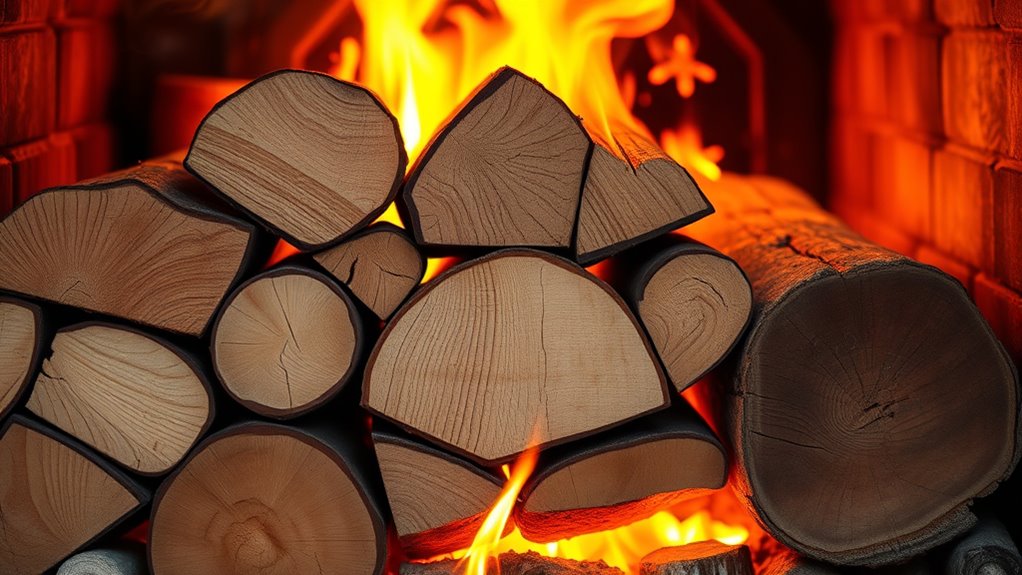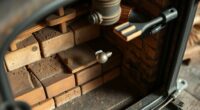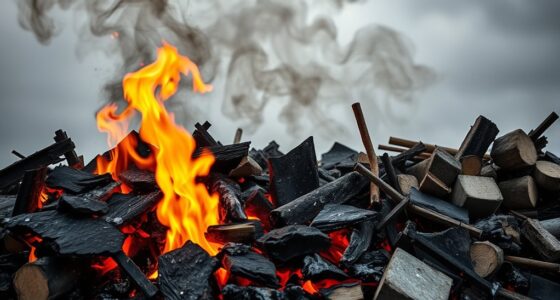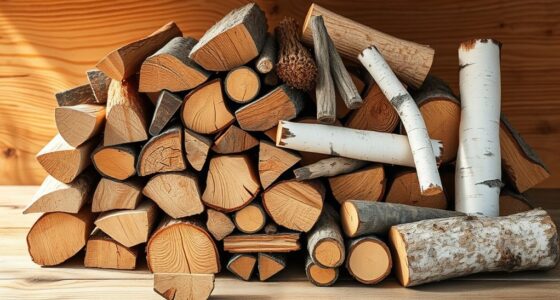The type of wood you burn greatly affects the heat output you get. Dense hardwoods like oak, hickory, and maple produce more heat and burn longer than softer woods like pine or spruce. Moisture content also plays a big role—well-seasoned wood burns cleaner and hotter. By choosing the right species and ensuring proper drying, you can maximize warmth and efficiency. Want to discover how to select and prepare the best firewood? Keep exploring for more tips.
Key Takeaways
- Hardwoods like oak, hickory, and maple have higher density and energy content, producing more heat per volume than softwoods.
- Softwoods such as pine and spruce ignite quickly but generally generate less heat than dense hardwoods.
- The wood’s species affects its oven-dried Btu value, with heavier, denser woods offering approximately 50% more heat output.
- Proper seasoning reduces moisture, which enhances the heat output regardless of wood type.
- Dense, seasoned woods burn longer and more efficiently, maximizing heat and minimizing creosote buildup.
Understanding How Different Woods Burn
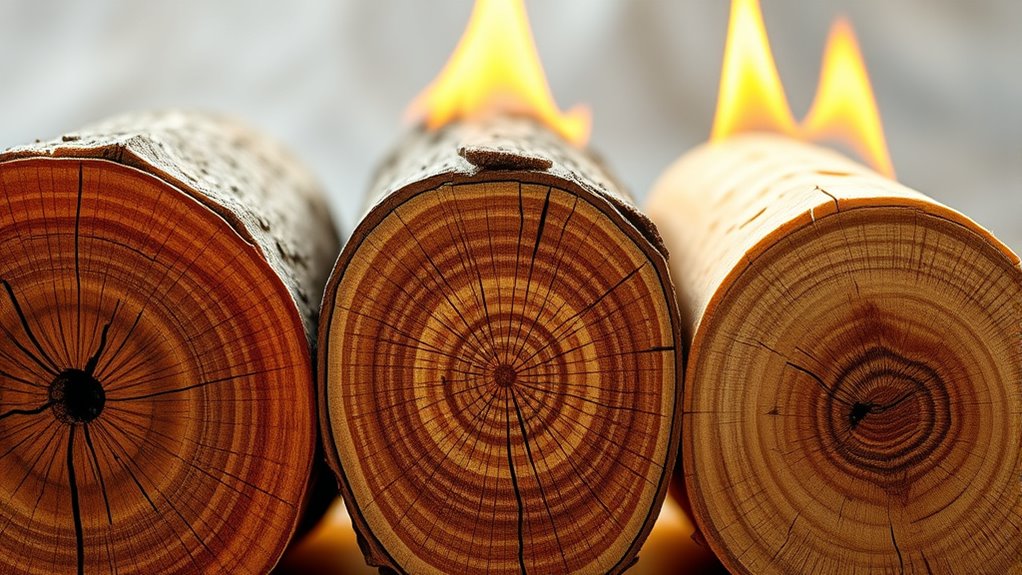
Understanding how different woods burn is essential for maximizing heat output and efficiency. The type of wood you choose influences how well it combusts and how much heat it produces. Heavier woods like oak and beech have higher density, meaning they contain more combustible material per volume, resulting in greater heat output. The moisture content of your firewood considerably affects combustion; properly seasoned wood with less than 20% moisture burns more efficiently, releasing more energy. Lignin-rich woods such as red cedar ignite quickly but produce less heat, while denser hardwoods ignite slower but burn longer and generate more energy. The overall heat output depends on the species, density, and seasoning of your wood, all of which determine how effectively your firewood burns and releases heat. Additionally, understanding wood combustion processes can help optimize your fire for better heat efficiency. Proper airflow and combustion efficiency are also crucial factors that influence how thoroughly and effectively the wood burns, maximizing heat output, especially when considering the effects of different wood types on burning performance.
Comparing Heat Values of Common Wood Species
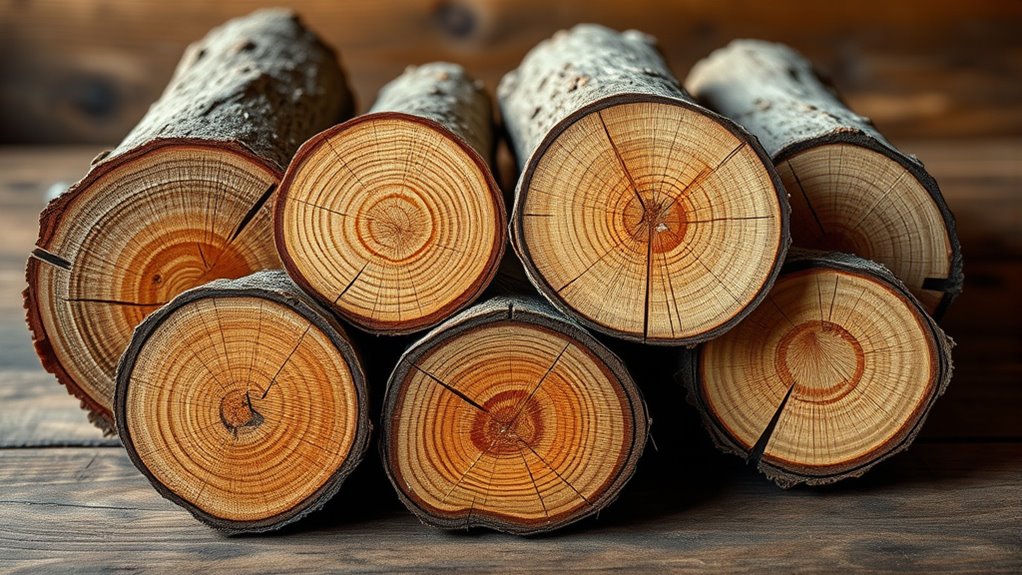
Different wood species vary markedly in their heat output, which directly impacts how much warmth your fire provides. Hardwoods like oak, hickory, and maple typically have higher heat values, around 8,600 to 9,050 Btu per pound when oven-dried, making them ideal for sustained heat. Softwoods such as pine, fir, and spruce generate slightly less heat—about 7,000 to 8,000 Btu—but burn more readily. Heavier woods like beech produce roughly 50% more heat than lighter species like spruce. The heat value depends heavily on moisture content; oven-dried wood offers maximum Btu per pound. Species comparison shows that woods with higher lignin, like cedar and oak, provide better fire resistance and consistent heat, while lighter woods ignite faster but produce less heat overall. Additionally, choosing the right wood can influence the cost and budgeting of your heating system, as some species are more affordable and readily available than others. Proper storage and seasoning of firewood also play a crucial role in achieving optimal heat output and maintaining safety during operation. Furthermore, the density of the wood affects how much heat it can produce, with denser woods generally offering higher energy content per unit volume.
Moisture Content and Its Effect on Heat Output

Moisture content plays an essential role in determining how much heat your firewood can produce. When wood has high moisture, it absorbs heat during combustion, reducing heat output and increasing smoke, soot, and creosote buildup. Dry wood with moisture below 20% offers the best heat value and combustion efficiency. Freshly cut wood, with around 75% moisture, produces about 4,900 Btu/lb, while air-dried wood at 20% moisture yields roughly 7,100 Btu/lb. Proper seasoning over months reduces firewood moisture, maximizing heat output. The table below illustrates the impact of moisture on heat value:
| Moisture Content | Approximate Heat Output |
|---|---|
| 75% (fresh wood) | 4,900 Btu/lb |
| 20% (air-dried) | 7,100 Btu/lb |
| 21%–25% | Decreased efficiency |
| >25% | Significant loss |
Additionally, understanding the moisture content helps optimize your firewood’s performance and safety. Maintaining appropriate firewood storage conditions is vital to prevent moisture absorption and ensure consistent heat output. Proper storage methods can significantly reduce the risk of excess moisture, leading to more efficient burning and safer operation.
The Role of Density and Structure in Heat Production

The density and structure of firewood directly impact how much heat it produces because they determine the amount of combustible material packed into a given volume. Denser woods like hardwoods—oak, hickory, and beech—contain more biomass per unit volume, resulting in higher heat output during combustion. The structure, including cell wall composition and fiber arrangement, influences how efficiently the wood burns; tightly structured hardwoods burn more completely and release more heat. Softwoods such as pine and fir have lower density and higher porosity, which causes them to burn faster but produce less total heat. Additionally, porosity and cellular arrangement affect airflow and combustion efficiency, with denser, less porous woods enabling sustained, higher heat output through ideal biomass utilization.
Choosing the Right Wood for Optimal Heating Efficiency
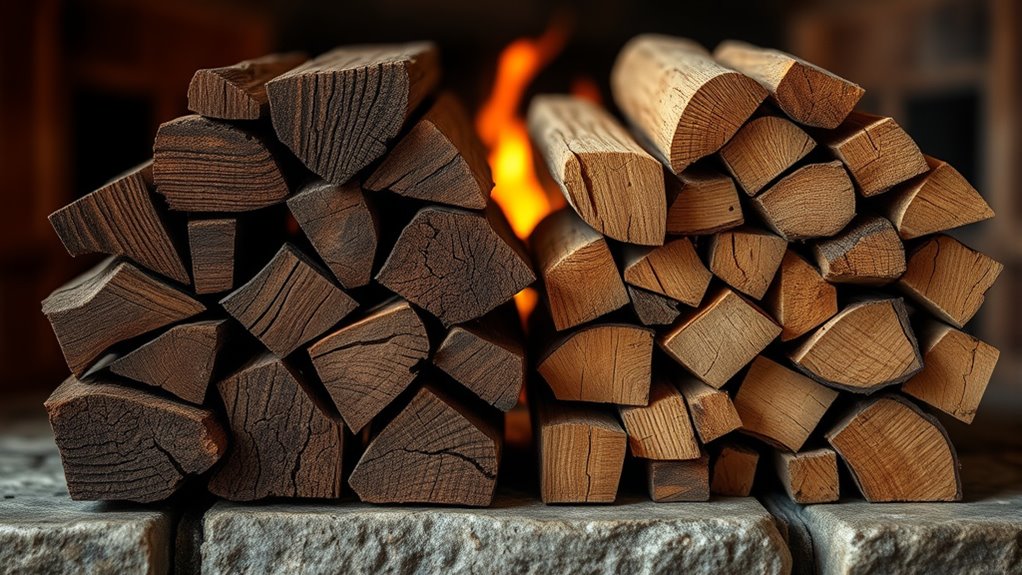
Choosing the right type of wood can considerably improve your heating efficiency. To maximize heat output, focus on these factors:
Selecting well-seasoned, dense hardwoods enhances your heating efficiency and maximizes heat output.
- Opt for seasoned wood with a moisture content below 20%, as it burns more efficiently and produces higher heat.
- Select dense wood species like oak or hickory, which generate about 50% more heat per volume than lighter woods.
- Choose high-density woods such as beech or holly, known for their higher lignin content, which increases heat during combustion.
- Prioritize hardwoods over softer woods, since the heat output depends more on seasoning and moisture content than on species alone.
- Additionally, using electric bikes for transportation can reduce emissions and support sustainable heating practices.
Practical Tips for Maximizing Heat From Your Firewood
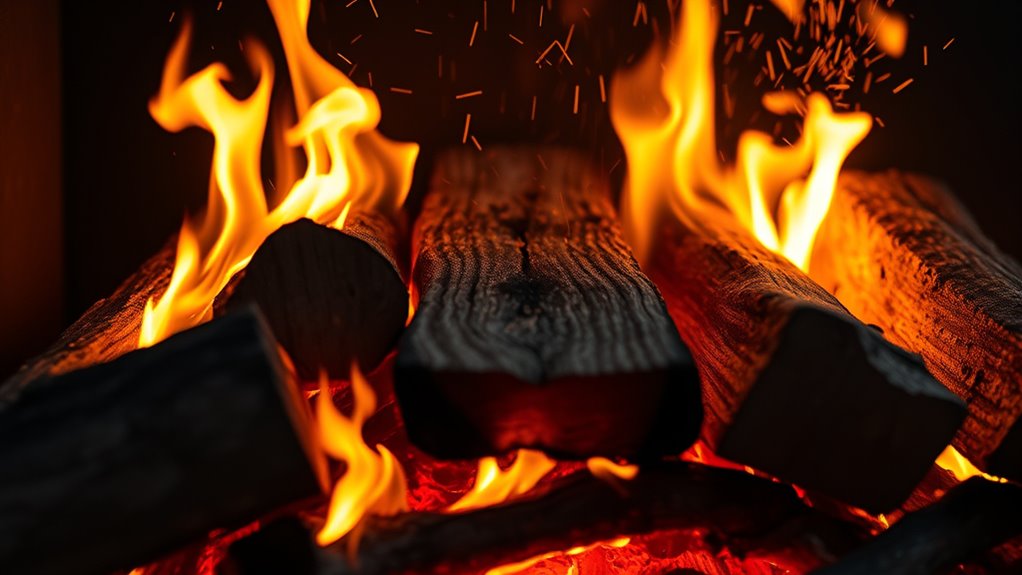
To get the most heat from your firewood, focus on using dry, well-seasoned wood with moisture below 20%. Choose dense hardwoods like oak or hickory for better heat output, and split your wood into smaller pieces to promote complete combustion. Properly stacking and maintaining your firewood guarantees consistent, efficient warmth from every fire. Additionally, utilizing air purifiers in your home can improve indoor air quality, making your space healthier and more comfortable during the heating season. Proper home organization can also help you store and select your firewood more efficiently, ensuring optimal dryness and readiness for use.
Choose Dry, Well-Seasoned Wood
Dry, well-seasoned firewood is essential for maximizing heat output and ensuring an efficient, clean burn. To achieve this, focus on these steps:
- Use dry, seasoned wood with moisture content below 20%, which boosts heat output by up to 30%.
- Properly dry your wood by splitting and stacking it in a sunny, windy spot, encouraging natural wood drying.
- Wait 6-12 months after cutting, allowing the wood to become well-aged.
- Use a moisture meter to confirm the wood has reached ideal dryness, maximizing heat efficiency and reducing creosote buildup.
- Selecting the appropriate wood type can further improve heat output and burning efficiency.
Opt for Dense Species
Opting for dense firewood like oak, hickory, or beech is one of the most effective ways to maximize heat output from your fires. Dense wood has high density, which directly correlates with increased BTU output during wood combustion. High-BTU species produce about 20-30% more heat per volume than lighter woods like pine or spruce. To get the best results, choose seasoned firewood with moisture content below 20%, as this enhances heat output and minimizes creosote buildup. Dense, high-density wood burns longer and provides sustained heat, making your fire more efficient. Selecting the right wood species ensures you need less wood overall, saving space and reducing the effort required to maintain a warm fire. Proper storage in a dry, ventilated area helps keep wood well-seasoned, ensuring maximum efficiency and heat output. Prioritize dense, well-seasoned wood for maximum heat and efficiency.
Properly Split and Stacked
Splitting your firewood into 2-6 inch pieces improves airflow around the wood, leading to more complete combustion and higher heat output. To maximize efficiency:
- Stack split firewood loosely in a dry, sunny, and windy spot.
- Keep the pile off the ground on pallets or metal racks to promote proper wood drying.
- Cover only the top with a metal sheet or weighted tarp, leaving sides open for ventilation.
- Allow at least six months for seasoning, reducing moisture content below 20%. Proper seasoning is crucial for increasing the firewood’s energy efficiency and ensuring a cleaner burn.
- Choosing the right water-resistant wood types can also enhance your firewood’s durability and heat output. Additionally, selecting woods with high-density ensures longer-lasting fires and greater heat retention.
- Ensuring proper airflow not only improves combustion but also minimizes creosote buildup, which can be a fire hazard and reduce heating efficiency. Proper stacking and ventilation are also essential for efficient burning, reducing emissions and improving overall heat output.
Frequently Asked Questions
What Is the Best Wood for Heat Output?
You’re wondering what the best wood for heat output is. Heavier, dense hardwoods like beech, oak, holly, and yew top the list because they produce more heat per volume. To get the most warmth, choose well-seasoned, dry hardwoods with moisture below 20%. Avoid lighter woods like spruce or willow, which generate less heat. Proper seasoning and selecting dense woods guarantee you maximize your heat output efficiently.
What Wood Gives off the Most Heat?
You’re probably wondering what wood gives off the most heat—well, some hardwoods like holly and oak are like fiery giants, producing extraordinary heat. These dense, seasoned woods reach about 7,100 Btu per pound, giving you maximum warmth. By choosing high-density, properly seasoned hardwoods, you’ll experience the hottest, most efficient fires, making your home cozy and your firewood investment well worth it.
How Does Wood Affect Thermal Energy?
You might wonder how wood affects thermal energy. When you burn wood, its species, moisture content, and density determine how much heat it produces. Heavier, well-seasoned hardwoods like oak or hickory release more BTUs per pound, giving you better warmth. Conversely, green or lightweight woods burn less efficiently, producing less heat. Choosing the right type and properly drying your wood guarantees you optimize thermal energy and get the most heat from your fire.
What Wood Is Best for Fuel?
Like the phoenix rising from ashes, your choice of wood determines your fire’s strength. For the best fuel, go for dense hardwoods like holly or yew, which produce higher BTUs and burn cleaner when seasoned properly. Avoid softwoods like pine, which can cause creosote buildup. Choose dry, seasoned wood with about 20% moisture for ideal heat output, ensuring a warm, efficient fire every time.
Conclusion
Choosing the right wood can make all the difference in maximizing your heat output. By understanding how different species burn, their moisture content, and their density, you can fire up more efficiently. So, next time you gather firewood, ask yourself: are you selecting the best wood for your needs? With the right choices, you’ll enjoy warmer, longer-lasting fires. Isn’t it worth putting a little thought into your wood to stay cozy all season?

